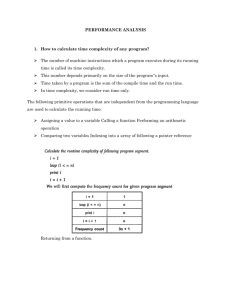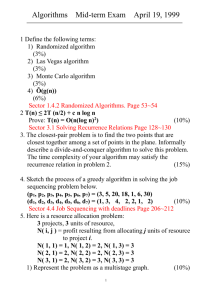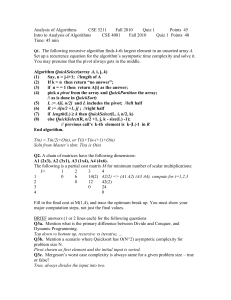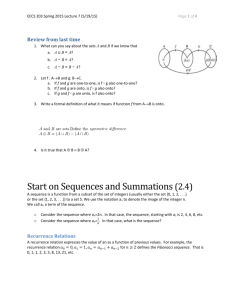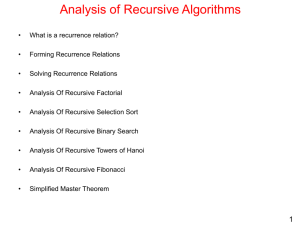Time Complexity Analysis of Recursive functions using Recurrence
advertisement
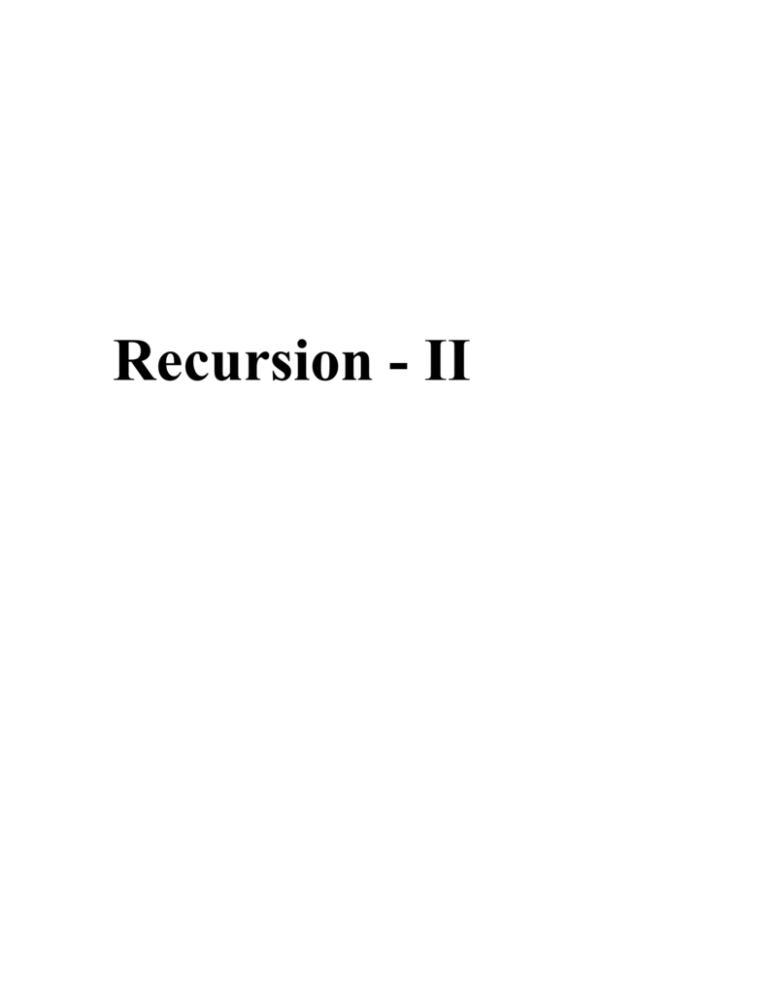
Recursion - II
Time Complexity Analysis of Recursive functions using
Recurrence relations:
The time complexity of an algorithm gives an idea of the number of operations needed to
solve it. While we shall discuss the time complexity issues in more detail later, in this
section we work out the number of operations for the some of the recursive functions that
we have developed so far. To do this we make use of recurrence relations. A recurrence
relation, also known as a difference equation, is an equation which defines a sequence
recursively: each term of the sequence is defined as a function of the preceding terms.
Let us look at the powerA function (exponentiation).
int powerA( int x, int n)
{
if (n==0)
return 1;
if (n==1)
return x;
else
return
x * powerA( x , n–1 );
}
The problem size reduces from n to n – 1 at every stage, and at every stage two arithmetic
operations are involved (one multiplication and one subtraction). Thus total number of
operations needed to execute the function for any given n, can be expressed as sum of 2
operations and the total number of operations needed to execute the function for n-1.
Also when n=1, it just needs one operation to execute the function
In other words T(n) can be expressed as sum of T(n-1) and two operations using the
following recurrence relation:
T(n) = T(n – 1 ) + 2
T(1) = 1
We need to solve this to express T(n) in terms of n. The solution to the recurrence
relation proceeds as follows. Given the relation
T(n) = T(n – 1 ) + 2
..(1)
we try to reduce the right hand side till we get to T(1) , whose solution is known to us.
We do this in steps. First of all we note (1) will hold for any value of n. Let us rewrite (1)
by replacing n by n-1 on both sides to yield
T(n – 1 ) = T(n – 2 ) + 2
…(2)
Substituting for T(n – 1 ) from relation (2) in relation (1) yields
T(n ) = T(n – 2 ) + 2 (2)
…(3)
Also we note that
T(n – 2 ) =
T(n – 3 ) + 2
…(4)
Substituting for T(n – 2 ) from relation(4) in relation (3) yields
T(n ) = T(n – 3 ) + 2 (3)
… (5)
Following the pattern in relations (1) , (3) and (5), we can write a generalized relation
T(n ) = T(n – k ) + 2(k)
…(6)
To solve the generalized relation (6), we have to find the value of k. We note that T(1) ,
that is the number of operations needed to raise a number x to power 1 needs just one
operation. In other words
T(1) = 1
...(7)
We can reduce T(n-k) to T(1) by setting
n–k=1
and solve for k to yield
k=n–1
Substituting this value of k in relation (6), we get
T(n) = T(1) + 2(n – 1 )
Now substitute the value of T(1) from relation (7) to yield the solution
T(n) = 2n– 1
..(8)
When the right hand side of the relation does not have any terms involving T(..), we say
that the recurrence relation has been solved. We see that the algorithm is linear in n.
Complexity of the efficient recursive algorithm for exponentiation:
We now consider the powerB function.
int powerB( int x, int n)
{
if ( n==0)
return 1;
if(n==1)
return x;
if (n is even)
return powerB( x * x,
n/2);
else
return powerB( x * x, n/2 ) * x
;
}
At every step the problem size reduces to half the size. When the power is an odd
number, an additional multiplication is involved. To work out time complexity, let us
consider the worst case, that is we assume that at every step an additional multiplication
is needed. Thus total number of operations T(n) will reduce to number of operations for
n/2, that is T(n/2) with three additional arithmetic operations (the odd power case). We
are now in a position to write the recurrence relation for this algorithm as
T(n)
T(1)
= T(n/2) + 3
=1
..(1)
..(1)
To solve this recurrence relation, we note that T(n/2) can be expressed as
T(n/2) = T(n/4) + 3
..(2)
Substituting for T(n/2) from (2) in relation (1) , we get
T(n)
= T(n/4) + 3(2)
By repeated substitution process explained above, we can solve for T(n) as follows
T(n)
= T(n/2) + 3
= [ T(n/4) + 3 ] + 3
= T(n/4) + 3(2)
= [ T(n/8) + 3 ] + 3(2)
= T(n/8) + 3(3)
Now we know that there is a relationship between 3 and 8, and we can rewrite the
recurrence relation as
T(n)
= T( n/ 23 ) + 3(3)
We can continue the process one step further, and rewrite the relation as
T(n)
= T( n/ 24 ) + 3(4)
Now we can see a pattern running through the various relations and we can write the
generalized relation as
T(n)
= T( n/ 2k) + 3(k)
Since we know that T(1) = 1, we find a substitution such that the first term on the right
hand side reduces to 1. The following choice will make this possible
2k= n
We can get the value of k by taking log of both sides to base 2, which yields
k = log n
Now substituting this value in the above relation, we get
T(n) = 1 + 3 log n
Thus we can say that this algorithm runs in LOGARITHMIC
much more efficient than the previous algorithm.
TIME, and obviously is
Complexity of the recursive Binary search function Rbinary:
The time complexity of the algorithm can be obtained by noting that every time the
function is called, the number of elements to be handled reduces to half the previous
value. Assuming it takes one operation for each of the 3 IF statements, and 2 operations
for computing mid, the total number of operations can be expressed through the
recurrence relation
T(n) = T( n/2) + 5
with
T(1) = 1
Note this relation is very similar to the one that we had for the efficient version of the
exponentiation algorithm, and it can be shown that the complexity of this algorithm is
also logarithmic.
Recurrence relation for the recursive Array handling function
arrayOdd:
int arrayOdd(int A[ ], int n)
{
if(n < 1)
return 0;
else
return A[n-1]%2 + arrayOdd( A, n-1);
}
In this function, the total number of operations reduce from size n to n-1 and every time
additional 4 arithmetic operations are carried out. Thus the recurrence relation for this
function is
T(n) = T(n – 1) + 4
T(1) = 1
Recurrence relation for a hypothetical recursive function
int hypo(int a, int n)
{
if(n == 1)
return 0;
else
return a + hypo(a,n-1) * hypo(a,n-1);
}
T(n) = 2 T(n – 1) + 3
T(1) = 1


